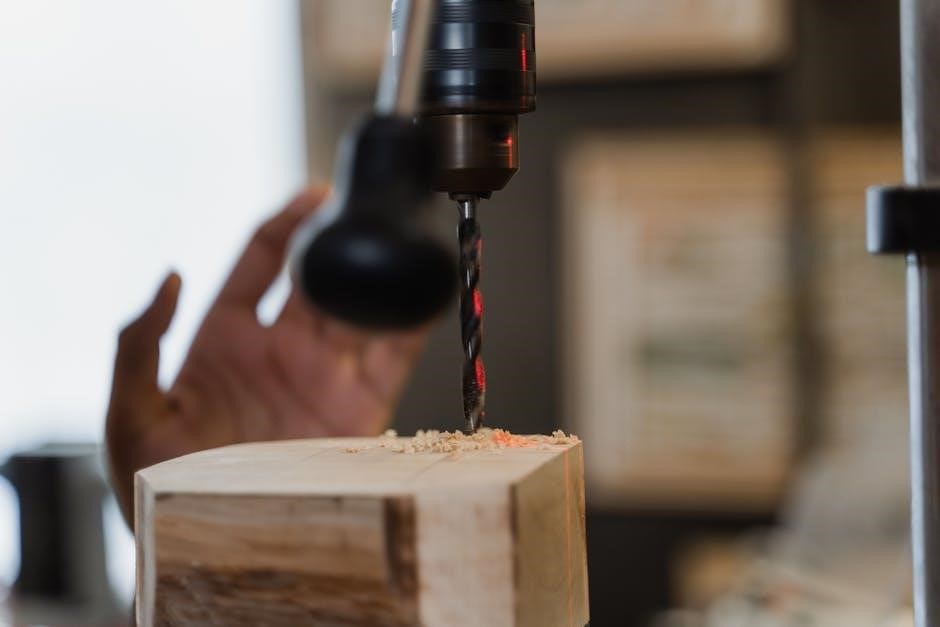Table Saw Guide Rollers: An Overview
Table saw guide rollers enhance safety and precision․ These tools aid in smooth, accurate cuts by keeping the wood firmly against the fence․ They reduce kickback risks and improve the woodworking experience․

Understanding Table Saw Guide Rollers
Table saw guide rollers are essential accessories designed to improve control and accuracy․ They press wood against the fence, ensuring straighter cuts, reducing vibration, and offering enhanced safety․ They are a valuable addition․
Purpose and Benefits of Guide Rollers
The primary purpose of table saw guide rollers is to enhance safety, precision, and control․ They achieve this by maintaining consistent pressure against the fence, ensuring straight, accurate cuts․ Guide rollers significantly reduce the risk of kickback, a dangerous event where the wood is ejected back towards the operator․
The benefits extend to improved cut quality․ By holding the stock firmly, guide rollers minimize vibration and prevent the wood from wandering during the cutting process․ This results in smoother edges and more consistent dimensions․ For users, this means less sanding and finishing work․
Guide rollers also increase efficiency, especially when working with larger pieces․ They allow the operator to focus on feeding the wood through the saw, rather than struggling to maintain pressure against the fence․ Ultimately, they provide safer, cleaner, and more efficient woodworking․
Types of Table Saw Guide Rollers
Table saw guide rollers come in several designs, each suited for specific needs․ One common type is the in-line roller system, which features rollers positioned directly in line with the fence․ These offer consistent pressure and are ideal for general ripping tasks․ Another type is the angled roller system, where rollers are set at a slight angle towards the fence․ This design enhances the grip on the wood, preventing movement against the feed direction․
Some guide rollers are integrated directly into the fence system, ensuring perfect alignment․ Others are aftermarket additions, offering flexibility in placement and adjustability․ Material varies, but urethane rollers are common due to their durability and grip․ Selecting the right type depends on the kind of cuts and the desired level of control․

Key Features and Design Considerations
When choosing table saw guide rollers, consider the roller angle for optimal grip․ Material durability and adjustability are also key․ Compatibility with your saw and fence setup matters greatly․
Roller Angle and Its Impact
The roller angle is a critical design element․ A slight angle, often around 5 degrees, steers the stock towards the fence, maintaining consistent pressure․ This optimized angle enhances the roller’s grip, preventing unwanted wood movement against the feed direction․
This steering action minimizes binding and promotes smoother cuts․ The angle ensures continuous contact between the wood and the fence, leading to improved accuracy and reduced kickback risk․ The camming angle, or angle of contact, should drive the device to lock․ Typically, 7 to 10 degrees is expected, but it depends on friction․
The angle’s effectiveness relies on balancing grip strength and ease of feed․ Too much angle might increase friction, while too little might compromise control․ Careful consideration of this angle is essential for optimal performance and safety․
Material and Durability
The material composition significantly influences the performance and longevity of table saw guide rollers․ High-quality materials ensure durability and resistance to wear and tear, crucial for withstanding continuous use․ Rollers often feature urethane tires, known for their excellent grip and resistance to abrasion․
The roller body and supporting structure need robust materials like high-grade steel or aluminum․ These materials provide the necessary strength to withstand the forces exerted during cutting operations and resist deformation․ Bearings are also important, as they can be made of one-way needle bearing․
Durability also depends on the quality of the bearings and mounting hardware․ Selecting materials that resist corrosion and maintain structural integrity ensures reliable performance and extends the lifespan of the guide rollers․ Proper material selection directly translates to enhanced safety and precision in woodworking tasks․
Adjustability and Compatibility
Adjustability and compatibility are essential factors when choosing table saw guide rollers․ Versatile guide rollers should offer easy adjustments for different stock thicknesses and fence heights, accommodating various woodworking projects․ Vertical travel and the ability to handle different stock thicknesses are important․
Compatibility with your table saw’s fence and T-slot size is crucial for proper installation and functionality․ Ensure the rollers fit standard T-slot dimensions (e․g․, 3/4 x 3/8 inch or 3/8 x 1/4 inch) for a secure and stable setup․ Some models include riser kits for compatibility with specific fences․
Adjustable roller arms and mounting hardware further enhance adaptability, allowing you to fine-tune the roller position for optimal performance․ Consider models that offer quick and easy adjustments to streamline your workflow and maximize the utility of your table saw guide rollers․
Safety Aspects of Table Saw Guide Rollers
Table saw guide rollers enhance safety by maintaining consistent pressure․ They help prevent kickback, ensuring smoother, more controlled cuts․ This reduces the risk of accidents in woodworking․
Kickback Prevention
Kickback is a significant hazard in table saw operation․ Guide rollers significantly reduce this risk by maintaining constant pressure against the fence․ The angled design of some rollers, like those in JessEm Clear-Cut TS Stock Guides, actively steers the stock towards the fence, enhancing grip and preventing movement against the feed direction․
One-way roller bearings are crucial for kickback prevention, ensuring the rollers only spin in the direction of the feed․ If the wood attempts to move backward, the rollers lock, halting the movement and preventing a dangerous kickback․
These features provide a safer working environment, allowing for more controlled and accurate cuts․ By keeping the workpiece secure, guide rollers minimize the chance of sudden, forceful ejection of the wood, protecting the operator from potential injury and promoting safer woodworking practices․
Popular Brands and Models
Several brands offer table saw guide rollers․ JessEm’s Clear-Cut TS Stock Guides are popular․ These guides enhance control, safety, and precision, delivering smooth cuts by holding the workpiece securely․
JessEm Clear-Cut TS Stock Guides
The JessEm Clear-Cut TS Stock Guides elevate your table saw experience․ They offer control and safety, achieving flawless cuts․ These guides hold the workpiece securely, ensuring accuracy and reducing accidents․
These guides operate like stock feeders, guiding stock at a slight angle․ Urethane tires on one-way needle bearings steer the stock towards the fence․ The stock is pushed against the fence, preventing kickback․
The rollers are mounted at a five-degree angle towards the fence․ This maintains side pressure during a cut, reducing kickback․ The angle enhances roller grip, preventing wood movement․ They feature fast setup and consistent hold-down pressure for clean cuts․
They are compatible with rip fences with flat top surfaces․ The roller arm holds the work under pressure․ Installation is fast and easy, improving precision and safety․

Installation and Setup
Installing table saw guide rollers properly ensures optimal performance and safety․ Begin by ensuring the guide rollers are compatible with your table saw’s T-slots․ Common sizes include 3/4 x 3/8 inch and 3/8 x 1/4 inch, so verify the fit․
Next, attach the guide rollers to the fence, ensuring they are aligned with the saw blade․ Misalignment can cause the wood to bind, affecting the cut’s accuracy․ Adjust the roller angle to about five degrees towards the fence; this helps maintain consistent pressure․
Secure the guide rollers tightly to prevent movement during operation․ Test the setup by running a piece of scrap wood through the saw․ Check for smooth, consistent feeding and adjust as needed to eliminate binding or uneven pressure․
Ensure the rollers provide adequate clearance for different wood thicknesses․

Maintenance and Troubleshooting
Regular maintenance of table saw guide rollers ensures longevity and consistent performance․ Begin by inspecting the rollers for wear and tear․ Replace worn or damaged rollers to maintain optimal grip and prevent slippage․ Clean the rollers regularly to remove dust, debris, and pitch, which can reduce their effectiveness․ Use a mild solvent and a clean cloth to wipe down the roller surfaces․
Check the bearings for smooth operation․ If the rollers are not spinning freely, lubricate the bearings with a light oil․ Ensure all fasteners are tight and secure․ Loose fasteners can cause misalignment and affect the guide rollers’ performance․
If you experience binding or uneven feeding, re-adjust the roller angle and alignment with the fence․ Verify the fence is parallel to the saw blade․ If kickback occurs, inspect the rollers for damage and ensure they are functioning correctly․ Replace any damaged parts immediately․

Write Reviews
Leave a Comment
No Comments & Reviews